First published: 1998
Last updated: February 25, 2023
Main sights of Anao Village include Anaoji Temple dedicated to the Bodhisattva Kannon, Mt. Takakuma, and a Shinto sanctuary called Obata Shrine.
| Excerpts from The Great Onisaburo Deguchi |
|
According to an old legend, long ago during a service at the shrine, a grain of rice fell from a tray of oblatory rice into a hole in the stump of a tree, and presently a rice shoot grew out of the hole. This rice gradually spread until the surrounding area was yielding superlative rice. Thus the village received the name Anaho ("ana" meaning hole, and "ho" meaning an ear of rice), later corrupted to the present Anao.
|
Here are some photos of the cave atop Mt. Takakuma, where Onisaburo had a weeklong initiatory experience.
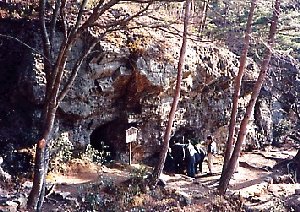
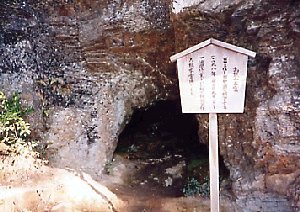
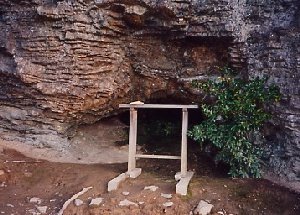
| Excerpts from The Great Onisaburo Deguchi |
|
...Kisaburo repeatedly sank into unconsciousness, experiencing a feeling of being sucked down, and when this had happened a number of times, he saw, in his semi-conscious state, a human figure in the shed with him. It was the figure of a man wearing Western clothes (= Deity Matsuoka), and he began talking to Kisaburo. After they had exchanged two or three remarks, Kisaburo followed the man out of Kiraku-tei. He had no clear idea of their purpose, only a vague feeling that they were going to Mount Fuji. This was on the night of March 1, 1898. Kisaburo left a note written on a roll of paper:
I am a bird flying in the sky....
Riding on a far, high cloud
I watch, in a trance,
the people in the world below
moving about
caught up in their joys and sorrows.
How funny the world of human beings....
The next morning, Kisaburo found himself sitting
in a shallow cave on the side of Mount Takakuma, a mountain near his birthplace. Somehow, although he seemed to have been heading for Mount Fuji, he was now on a moutain a little over a mile from his house. The man who had led him out of his shed the previous night was nowhere to be seen. He was sitting upright on a rock with his eyes closed as an icy wind howled across the high, snow-covered peak.
At the time there was a luxuriant covering of old trees from the foot of this mountain to about halfway up its slope, and on the summit there was a forest of small pine trees. Halfway up the sheer cliff facing the valley, great rocks jutted out and gaping caves opened deep within.
Kisaburo observed that some irresistible force was holding him upright and at the same time drawing him into a mysterious world. Since childhood Kisaburo had been especially prone to flashes of intuition. Although there was at the same time something dreamy about him, this sixth sense was very sharp, and as he became older, it slowly developed.
Now, on the mountain, his powers had taken an enormous leap. With the events of the previous night as a turning point, Kisaburo had entered another world, a completely different dimension. His mind was like a bird spreading its wings and freely soaring through space. Whatever he thought instantly appeared before his eyes. After wandering for a while in this world in a sort of ecstacy, he would return to prayer and meditation. Then, while he was praying, he set off on a journey into a world that was neither dream nor reality..
Kisaburo sat on the rock fasting for one week. When he eventually returned to his senses, he saw that all he was wearing was his under-komono.
Through this week-long asceticism on Mount Takakuma, Kisaburo entered the state of what is called kamigakari , or divine possession. In later years he was to set down a record of this experience in Reikai Monogatari . In the first volume he makes the bold pronouncement, "After completing one week of discipline on the holy mountain of Takakuma near Anao in Tamba, I gained an understanding of the basics of clairvoyance, clairaudience, telepathy, communication with the divine and an understanding of karma....
|

 Anaoji Temple  Kaiko Elementary School within Anaoji Temple
Onisaburo went to Kaiko Elementary School. Later, he became a substitute teacher
at age 11! (See below)
| Excerpts from The Great Onisaburo Deguchi |
|
The headmaster of the temple school, a former retainer of the Lord of Kameyama and rather a spirited man, filled the space left by the departed teacher in a highly unorthodox way. He had punished both parties to the quarrel, and now, faced with the problem of the teacher's replacement, he turned to the expelled Kisaburo (= Onisaburo's real name), who had from the beginning shown outstanding ability in class, and invited him to fill the vacancy. The headmaster was well aware of Kisaburo's scholastic ability, brought about thanks to his grandmother and enhanced by his studies at school and at evening classes, so he and the other school authorities made this unusual settlement to the affair, the cause of which had been the teacher's fault in the first place.
|
 Obata Bridge
Leaving her uncle's riverside inn in Fushimi and crossing Oi no Saka Pass, Yone (Onisaburo's mother) came back to Anao and took a rest on this bridge - with child by Prince Taruhito of the Arisugawa Clan of the Imperial Family.
 Obata River (Inukai River)
After his initiatory experience on Mt. Takakuma, Onisaburo sat straight in this river only in underwear and prayed to Kami.
Onisaburo cured the pain of Jiromatsu Ueda with the Ama-no-Kazu-Uta (Chant of Heavenly Numbers).
Onisaburo learned the Three Rules of Learning from Deity Kototama-hiko:
- Observing the true phenomena of heaven and earth, and you will see the substance of the true Kami.
- Recognize the unerring functioning of all things, and you will see the energy of the true Kami.
- Penetrate into the essential nature of living beings, and you will see the spirit of the true Kami.
This shrine is dedicated to the 9th Emperor Kaika.
 Residence of Ran Saito
Ran Saito is the very first girl Onisaburo fell in love with. She was a daughter of a landlord, while Kisaburo was a son of a peasant family. Due to this difference in social status, their romance had a sad ending.
Onisaburo decided to be independent and started living in this shed near his home.
Onisaburo had a romance with his girlfriend Koto.
Onisaburo learned from his mother Yone and his grandmother Uno that his real father was Prince Taruhito of the Arisugawa Clan. A while after this dramatic revelation, Deity Matsuoka appeared and took Onisaburo to Mt. Takakuma so that he could explore the spiritual world as part of his initiatory experience.
| Excerpts from The Great Onisaburo Deguchi |
|
...Kisaburo repeatedly sank into unconsciousness, experiencing a feeling of being sucked down, and when this had happened a number of times, he saw, in his semi-conscious state, a human figure in the shed with him. It was the figure of a man wearing Western clothes (= Deity Matsuoka), and he began talking to Kisaburo. After they had exchanged two or three remarks, Kisaburo followed the man out of Kiraku-tei. He had no clear idea of their purpose, only a vague feeling that they were going to Mount Fuji. This was on the night of March 1, 1898. Kisaburo left a note written on a roll of paper:
I am a bird flying in the sky....
Riding on a far, high cloud
I watch, in a trance,
the people in the world below
moving about
caught up in their joys and sorrows.
How funny the world of human beings....
The next morning, Kisaburo found himself sitting in a shallow cave on the side of Mount Takakuma, a mountain near his birthplace. Somehow, although he seemed to have been heading for Mount Fuji, he was now on a moutain a little over a mile from his house. The man who had led him out of his shed the previous night was nowhere to be seen. He was sitting upright on a rock with his eyes closed as an icy wind howled across the high, snow-covered peak.
At the time there was a luxuriant covering of old trees from the foot of this mountain to about halfway up its slope, and on the summit there was a forest of small pine trees. Halfway up the sheer cliff facing the valley, great rocks jutted out and gaping caves opened deep within.
Kisaburo observed that some irresistible force was holding him upright and at the same time drawing him into a mysterious world. Since childhood Kisaburo had been especially prone to flashes of intuition. Although there was at the same time something dreamy about him, this sixth sense was very sharp, and as he became older, it slowly developed.
Now, on the mountain, his powers had taken an enormous leap. With the events of the previous night as a turning point, Kisaburo had entered another world, a completely different dimension. His mind was like a bird spreading its wings and freely soaring through space. Whatever he thought instantly appeared before his eyes. After wandering for a while in this world in a sort of ecstacy, he would return to prayer and meditation. Then, while he was praying, he set off on a journey into a world that was neither dream nor reality..
Kisaburo sat on the rock fasting for one week. When he eventually returned to his senses, he saw that all he was wearing was his under-komono.
Through this week-long asceticism on Mount Takakuma, Kisaburo entered the state of what is called kamigakari , or divine possession. In later years he was to set down a record of this experience in Reikai Monogatari . In the first volume he makes the bold pronouncement,
After completing one week of discipline on the holy mountain of Takakuma near Anao in Tamba, I gained an understanding of the basics of clairvoyance, clairaudience, telepathy, communication with the divine and an understanding of karma....
|

 Former site of Onisaburo's dairy farm
Onisaburo used the knowledge and experience he gained at his cousin's
farm in Sonobe to establish a farm of his own near his house in Anao. He
worked hard at his farm, and Ueda Dairy became a successful enterprise.
This place is associated with Onisaburo's romance with Ino Saito.
Though they did not formally register their marriage, Ino and Onisaburo
enjoyed 100 days of married life.
Ino in later years would often ask about Onisaburo, saying, "How's
Kisa-yan (=Onisaburo) doing? Is he well?" when she saw people who knew
about Onisaburo's daily life. The same applies to any woman Onisaburo had
a romance with.
Originally, Onisaburo's home.
The Ueda family used to be an influential one in the area. However,
a succession of profligate sons had brought about the downfall of the family,
reducing its vast holdings to one poor farmer's hovel.
| Excerpts from The Great Onisaburo Deguchi |
|
Kichimatsu, Onisaburo's grandfather, made his own contribution to this unfortunate tradition, plunging the family situation to greater depths by his addiction to gambling. In Onisaburo's autobiography we learn that when his grandfather's wife Uno tried to remonstate, Kichimatsu would turn a deaf ear saying, "Don't worry. Providence looks after even the birds of the air. Birds and beasts do not save for tomorrow, yet they do not starve. It's the same with human beings. Out of a thousand people only one or two die of starvation. The other nine hundred and ninety-nine all die of overeating." Not only that, but he held the belief that things would have to get worse for the Uedas before they could get better, and claimed as his authority the deity of the local shrine. "Unless the Ueda family loses its house and land, our luck will not turn--or so the god tells me at night. If I stop gambling for a single day, that night the god appears to me and demands angrily, 'Why do you disobey me?'
Such being the state of affairs, by the time Onisaburo began to be aware of things around him, the once prosperous Ueda family had lost nearly all its lands, lived in a tiny two-room shack, and possessed rice fields amounting to about one hundred square yards.
Not long after Onisaburo was born, his grandfather Kichimatsu passed away at the age of fifty-eight. The dying Kichimatsu called his son and his son's wife to his bedside and made the following announcement: "From long ago in the Ueda family, every seventh generation produces a great man who makes a mark in the world. The famous painter Okyo Maruyama (1733-1795; real name Mondo Ueda) was the son of my great-great-great grandfather Jirozaemon Ueda and the daughter of the retainer of a daimyo in western Tamba Province. My grandson is seven generations after Okyo, and he will certainly make a name for himself in some way. When I took
the baby to a fortune teller in Kameyama, the fortune teller said that he would leave his ancestral home if allowed to study too much, that he is a most unusual child, and that we should bring him up carefully. My life is at an end, but after I am gone, my spirit will guide him."
Then, we are told, after singing a song about how he had given himself to gambling all his life and how he intended to go right on doing the same in the next world, he passed away.
|
Unable to complete his mission of gambling away his family fortune,
Kichimatsu Ueda was born again as Yoshimatsu Ueda, Onisaburo's younger
brother, to resume gambling! (In fact, Yoshimatsu was just as great a gambler
as his former incarnation.)

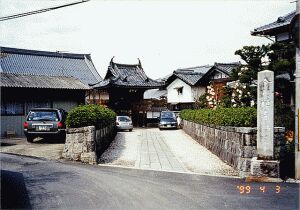 Kongoji Temple (Okyoji Temple)
A leading painter in the Edo period, Okyo Maruyama (1733-1795;
real name Mondo Ueda), also an ancestor of Onisaburo, entered Buddhism
at this temple.
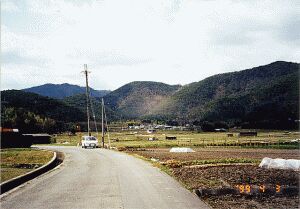 A road to Mt. Takakuma
 The Nishiyama Cemetary near Mt. Takakuma
Onisaburo's sister Yuki and her husband (Motokichi Nishida) rest in peace.
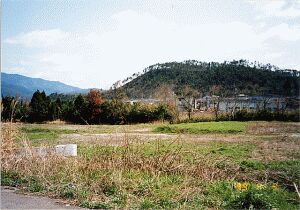 Matsu no shita Matsu no shita (Under the pine trees)
Onisaburo was attacked by some men under Kankichi Kawachiya, a kind
of gangster but was saved by Katsukichi Ueda. Soon after this fight came
a revelation at the Kiraku-tei shed that Onisaburo was a son
of Prince Taruito, and Deity Matsuoka guided him through the spiritual
world. (See above)
 Anao Bridge
 Junrei Bridge
|
